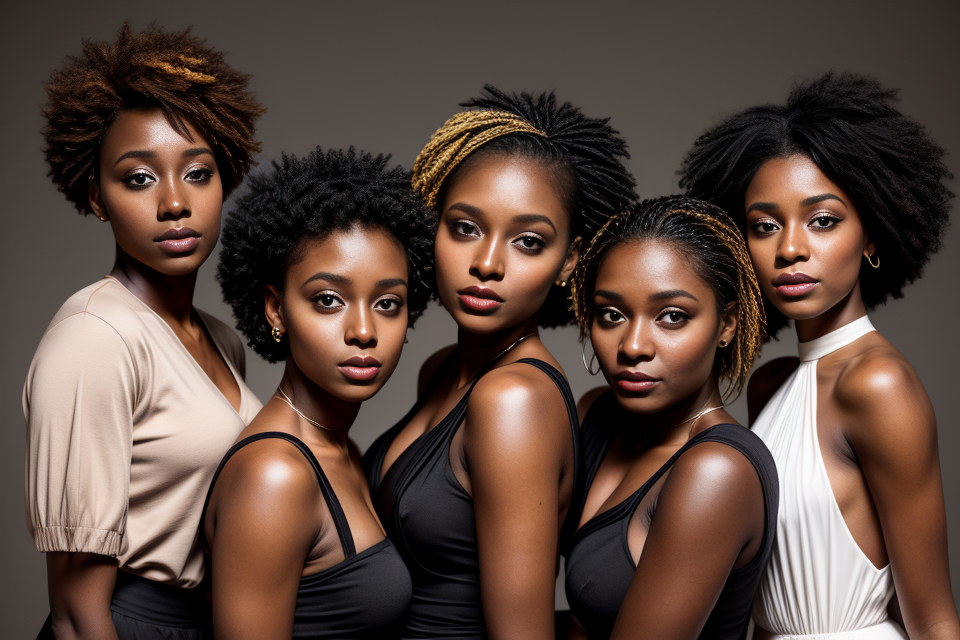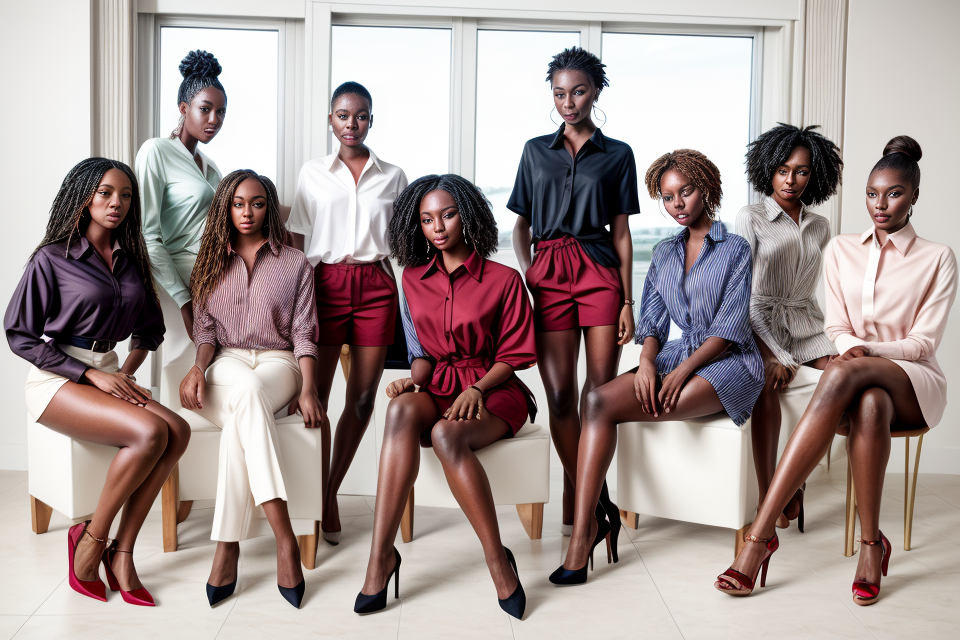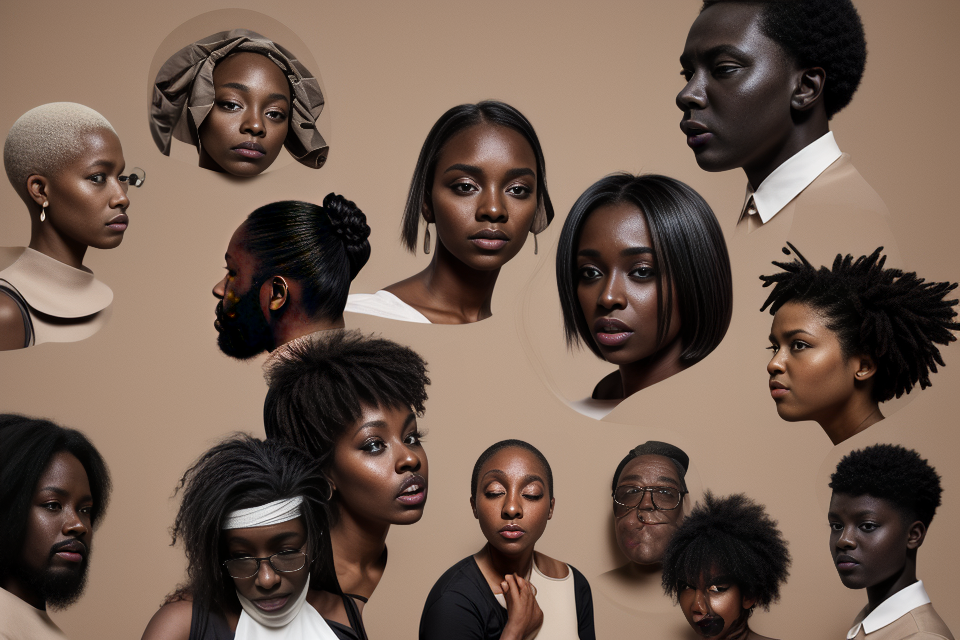When it comes to fashion and beauty, everyone wants to look their best. But for people with dark skin tones, choosing the right colors can be a challenge. Some colors can wash out the skin, while others can make it look dull and lifeless. In this article, we will explore the colors that dark skin tones should avoid to achieve a flawless and radiant look. From bold hues to pastel shades, we will cover it all. So, whether you’re a makeup artist, fashion designer, or simply a beauty enthusiast, read on to discover the secrets to achieving a stunning look with the right color choices.
Dark skin tones should avoid wearing colors that are too pale or pastel, as they can wash out the skin and make it appear dull. Instead, they should opt for bold and vibrant colors that will complement their natural skin tone. Colors such as red, purple, and deep blue can look stunning on dark skin tones, while lighter shades of these colors can be used as accents. Black is also a classic color that can be worn by people with dark skin tones, as it is a neutral color that can make the skin appear more radiant.
Understanding Skin Tones
What is dark skin?
Dark skin is a complexion with a higher concentration of melanin in the skin cells. Melanin is a pigment that gives color to the skin, hair, and eyes. It is produced by cells called melanocytes, which are located in the outer layer of the skin. Dark skin is commonly found in people of African, Asian, and Hispanic descent.
It is important to note that while people with dark skin may have different shades, they are all considered within the same range of skin tones. Dark skin is not a single skin type, but rather a broad category that encompasses various skin tones. Therefore, it is essential to be mindful of the colors that work best for each individual’s unique skin tone.
The importance of considering skin tone when choosing colors
When it comes to choosing colors that flatter your skin tone, it’s important to understand that different skin tones can look good in different colors. However, certain colors can be more flattering than others, depending on your skin tone. This is why it’s important to consider your skin tone when choosing colors, especially if you have a dark skin tone.
Having a dark skin tone means that you have more melanin in your skin, which can affect how certain colors look on you. For example, colors that may look great on someone with lighter skin may not look as good on someone with darker skin. This is because darker skin tones can appear more saturated or rich, which can make certain colors appear more vibrant or intense.
On the other hand, some colors can wash out or appear dull on darker skin tones. This is why it’s important to be mindful of the colors you choose when dressing or decorating, so that you can make sure they complement your skin tone and not wash it out.
So, if you have a dark skin tone, it’s important to be mindful of the colors you choose, and avoid certain colors that may not flatter your skin tone. In the next section, we’ll explore which colors dark skin tones should avoid.
Common Mistakes to Avoid
Choosing colors that are too light or pastel
When it comes to choosing colors that complement dark skin tones, it’s important to avoid certain shades that can make the skin appear washed out or sallow. One common mistake to avoid is choosing colors that are too light or pastel. These colors can clash with the natural warmth of dark skin and can make it appear dull and lackluster.
Pastel colors, such as pale pink, blue, and yellow, can be particularly problematic for those with dark skin tones. These colors are often associated with delicacy and femininity, but when worn by those with dark skin, they can come across as cheap and artificial.
Additionally, pastel colors can often appear chalky or ghostly on dark skin, which can make the skin appear even more pale and washed out. These colors can also exacerbate any redness or discoloration in the skin, which can be a particular issue for those with deeper skin tones.
It’s important to note that while pastel colors may be popular and trendy, they are not always flattering for everyone. Those with dark skin tones should instead opt for rich, jewel tones and earthy hues that complement their natural coloring.
Some examples of colors that work well with dark skin tones include deep purples, blues, and greens, as well as rich shades of red and gold. These colors add depth and warmth to the skin, while also providing a striking contrast that can help draw attention to the face.
Ultimately, when choosing colors to wear, it’s important to consider the undertones of your skin. If you have cool undertones, you may find that you look best in cool, muted shades, while those with warm undertones may prefer brighter, more saturated colors. Experimenting with different shades and combinations can help you find the colors that work best for you and flatter your unique skin tone.
Choosing colors that are too dark or muted
Dark skin tones should avoid choosing colors that are too dark or muted as they can make the skin appear dull and lackluster. This is because dark skin has less pigmentation than lighter skin, and therefore requires brighter and more vibrant colors to bring out the natural glow of the skin. When choosing colors, it is important to consider the undertone of the skin, whether it is warm or cool, and choose colors that complement the undertone rather than clashing with it.
Choosing colors that clash with your skin tone
Dark skin tones are rich and deep, but choosing the wrong colors can make them appear dull and washed out. To avoid this, it’s important to know which colors clash with your skin tone and which ones complement it.
One common mistake is to wear colors that are too pale or pastel. These colors can make dark skin tones look sallow and sickly. Instead, opt for brighter, bolder shades that will bring out the richness of your skin tone.
Another mistake to avoid is wearing colors that are too similar in tone to your skin. For example, if you have dark brown skin, avoid wearing clothing that is also a dark brown shade. This can create a muddy, unflattering look.
It’s also important to be aware of the undertone of your skin. If you have warm undertones, you may want to avoid cool or blue-based colors, as they can make your skin look sallow and sickly. On the other hand, if you have cool undertones, you may want to avoid warm or yellow-based colors, as they can clash with your skin tone.
Overall, the key is to choose colors that complement your skin tone and bring out its natural beauty. By avoiding colors that clash with your skin, you can create a look that is both stylish and flattering.
Choosing the Right Colors
Understanding color theory
When it comes to choosing the right colors for dark skin tones, understanding color theory is essential. Color theory is the study of how colors interact with each other and how they can be used to create different effects. Here are some key concepts to keep in mind:
- Complementary colors: These are colors that are opposite each other on the color wheel, such as blue and orange or green and red. When used together, complementary colors can create a vibrant and eye-catching contrast. However, they can also clash and be overwhelming if not used carefully.
- Analogous colors: These are colors that are next to each other on the color wheel, such as blue, green, and yellow. Analogous colors can create a harmonious and cohesive look, but they can also become monotonous if overused.
- Contrasting colors: These are colors that are different from each other, such as black and white or red and purple. Contrasting colors can create a bold and dramatic effect, but they can also clash and be overwhelming if not used carefully.
- Neutral colors: These are colors that are neither particularly warm nor particularly cool, such as gray, beige, and taupe. Neutral colors can create a calming and sophisticated look, but they can also appear dull and uninteresting if not used with other colors.
By understanding these basic concepts of color theory, you can make more informed choices when it comes to choosing colors that will complement your dark skin tone.
Choosing colors that complement your skin tone
When it comes to choosing colors that complement your skin tone, there are a few key things to keep in mind. First, it’s important to understand that different skin tones require different color palettes. For example, warm undertones work best with cool colors, while cool undertones work best with warm colors.
To determine your undertone, you can look at the veins on your wrist. If they appear green, you have a warm undertone. If they appear blue or purple, you have a cool undertone.
Once you know your undertone, you can start to choose colors that complement it. Here are a few tips to keep in mind:
- For warm undertones, stick to colors like peach, coral, and gold. These colors will help to bring out the warmth in your skin.
- For cool undertones, opt for colors like navy, charcoal, and black. These colors will help to bring out the coolness in your skin.
- If you have a neutral undertone, you can wear any color, but it’s still important to consider the colors that look best on you. For example, if you have a neutral undertone with a cooler skin tone, you may want to avoid bright or neon colors.
When choosing colors, it’s also important to consider the occasion and the setting. For example, bright and bold colors may be more appropriate for a party or a night out, while muted and subdued colors may be better for a formal or professional setting.
Overall, choosing the right colors can make a big difference in how you look and feel. By taking the time to understand your skin tone and undertone, you can choose colors that complement your natural beauty and help you feel confident and put-together.
Tips for mixing and matching colors
When it comes to choosing the right colors for dark skin tones, there are a few tips to keep in mind. One of the most important things to remember is to avoid colors that are too pale or washed out. These colors can make dark skin tones look sallow and sickly. Instead, opt for colors that are rich and deep, with a good level of saturation.
Another important tip is to avoid colors that are too dark or muted. These colors can make dark skin tones look flat and dull, and can also make it difficult to achieve a harmonious color scheme. Instead, choose colors that are bright and vibrant, but also have enough contrast to create visual interest.
It’s also important to consider the undertone of your skin when choosing colors. If you have warm undertones, look for colors that have a warm undertone, such as reds, oranges, and yellows. If you have cool undertones, look for colors that have a cool undertone, such as blues, greens, and purples.
Finally, when mixing and matching colors, it’s important to keep the color wheel in mind. Colors that are opposite each other on the color wheel, such as blue and orange, are called complementary colors. These colors can create a striking contrast when used together, but it’s important to use them in moderation to avoid an overly clashing look. Other colors, such as analogous colors (colors that are next to each other on the color wheel), can be used together in larger quantities to create a more harmonious look.
Accessorizing with color
When it comes to accessorizing with color, it’s important for individuals with dark skin tones to be mindful of the colors they choose. Here are some tips to keep in mind:
- Avoid colors that are too light or pastel: These colors can wash out dark skin tones and make them appear even darker. Instead, opt for bolder, richer colors that will complement your skin tone.
- Choose colors that are opposite your undertone: If you have warm undertones, opt for cool colors like blue and purple. If you have cool undertones, opt for warm colors like orange and red.
- Be mindful of saturation: Dark skin tones can handle bold, highly saturated colors, but it’s important to balance them out with neutral or complementary colors to avoid looking overwhelmed.
Overall, when accessorizing with color, it’s important to choose colors that complement your skin tone rather than clash with it. By paying attention to these tips, you can ensure that your outfits are cohesive and visually appealing.
Further reading
- “The Skin Tone Color Chart: How to Choose the Right Colors for Your Skin Tone” by The Beauty Guru
- “Skin Tone Color Matching: The Ultimate Guide for Flawless Makeup” by Makeup.com
- “Skin Tone and Makeup: The Perfect Match” by Allure
- “Choosing the Right Colors for Your Skin Tone: A Comprehensive Guide” by Harper’s Bazaar
- “The Science of Skin Tone and Makeup: How to Find Your Perfect Match” by Marie Claire
FAQs
1. What colors should dark skin tones avoid?
Dark skin tones should avoid wearing colors that are too light or pastel, as they can wash out the skin and make it appear dull. Instead, it’s best to stick to rich, deep colors that complement the skin tone. For example, bright pinks, yellows, and whites can be too harsh on dark skin, while navy blue, deep red, and rich green can look stunning.
2. Can dark skin tones wear black?
Yes, dark skin tones can wear black. In fact, black is a classic color that can look great on many different skin tones. However, it’s important to choose the right shade of black. Avoid wearing matte black, as it can make the skin look dull and lifeless. Instead, opt for a high-shine black or a deep, rich navy blue.
3. What colors should dark skin tones avoid wearing with blue jeans?
When it comes to blue jeans, dark skin tones should avoid wearing light or pastel colors, such as white, cream, or pale pink. These colors can clash with the blue jeans and make the outfit look unbalanced. Instead, opt for darker, richer colors such as burgundy, navy, or olive green. These colors will complement the blue jeans and create a cohesive, stylish look.



